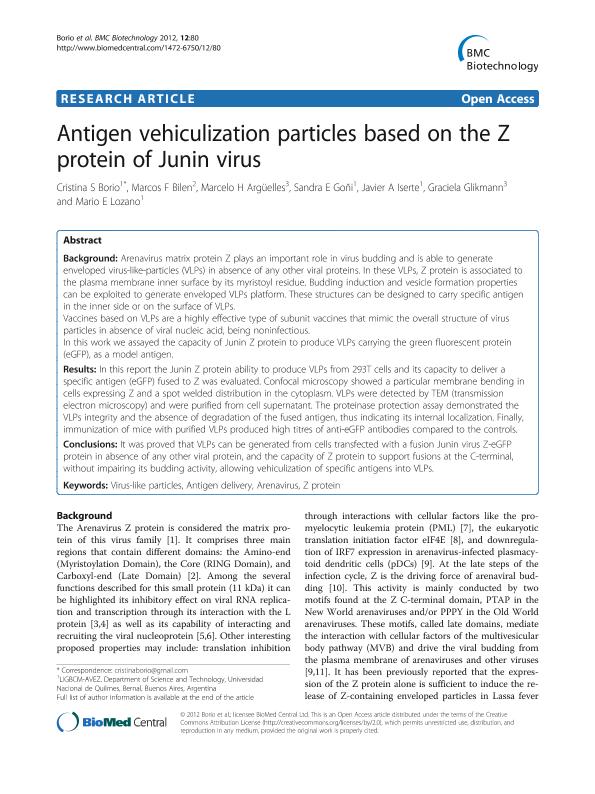Mostrar el registro sencillo del ítem
dc.contributor.author
Borio, Cristina Silvia

dc.contributor.author
Bilen, Marcos Fabian

dc.contributor.author
Argüelles, Marcelo Horacio

dc.contributor.author
Goñi, Sandra Elizabeth

dc.contributor.author
Iserte, Javier Alonso

dc.contributor.author
Glikmann, Graciela
dc.contributor.author
Lozano, Mario Enrique

dc.date.available
2023-03-21T17:18:11Z
dc.date.issued
2012-11
dc.identifier.citation
Borio, Cristina Silvia; Bilen, Marcos Fabian; Argüelles, Marcelo Horacio; Goñi, Sandra Elizabeth; Iserte, Javier Alonso; et al.; Antigen vehiculization particles based on the Z protein of Junin virus; BioMed Central; Bmc Biotechnology; 12; 11-2012; 1-9
dc.identifier.issn
1472-6750
dc.identifier.uri
http://hdl.handle.net/11336/191245
dc.description.abstract
Background: Arenavirus matrix protein Z plays an important role in virus budding and is able to generate enveloped virus-like-particles (VLPs) in absence of any other viral proteins. In these VLPs, Z protein is associated to the plasma membrane inner surface by its myristoyl residue. Budding induction and vesicle formation properties can be exploited to generate enveloped VLPs platform. These structures can be designed to carry specific antigen in the inner side or on the surface of VLPs.Vaccines based on VLPs are a highly effective type of subunit vaccines that mimic the overall structure of virus particles in absence of viral nucleic acid, being noninfectious.In this work we assayed the capacity of Junin Z protein to produce VLPs carrying the green fluorescent protein (eGFP), as a model antigen.Results: In this report the Junin Z protein ability to produce VLPs from 293T cells and its capacity to deliver a specific antigen (eGFP) fused to Z was evaluated. Confocal microscopy showed a particular membrane bending in cells expressing Z and a spot welded distribution in the cytoplasm. VLPs were detected by TEM (transmission electron microscopy) and were purified from cell supernatant. The proteinase protection assay demonstrated the VLPs integrity and the absence of degradation of the fused antigen, thus indicating its internal localization. Finally, immunization of mice with purified VLPs produced high titres of anti-eGFP antibodies compared to the controls.Conclusions: It was proved that VLPs can be generated from cells transfected with a fusion Junin virus Z-eGFP protein in absence of any other viral protein, and the capacity of Z protein to support fusions at the C-terminal, without impairing its budding activity, allowing vehiculization of specific antigens into VLPs.
dc.format
application/pdf
dc.language.iso
eng
dc.publisher
BioMed Central

dc.rights
info:eu-repo/semantics/openAccess
dc.rights.uri
https://creativecommons.org/licenses/by/2.5/ar/
dc.subject
ANTIGEN DELIVERY
dc.subject
ARENAVIRUS
dc.subject
VIRUS-LIKE PARTICLES
dc.subject
Z PROTEIN
dc.subject.classification
Bioquímica y Biología Molecular

dc.subject.classification
Ciencias Biológicas

dc.subject.classification
CIENCIAS NATURALES Y EXACTAS

dc.title
Antigen vehiculization particles based on the Z protein of Junin virus
dc.type
info:eu-repo/semantics/article
dc.type
info:ar-repo/semantics/artículo
dc.type
info:eu-repo/semantics/publishedVersion
dc.date.updated
2023-03-20T14:49:46Z
dc.journal.volume
12
dc.journal.pagination
1-9
dc.journal.pais
Reino Unido

dc.journal.ciudad
Londres
dc.description.fil
Fil: Borio, Cristina Silvia. Universidad Nacional de Quilmes. Departamento de Ciencia y Tecnología. Laboratorio de Ingeniería Genética y Biología Molecular y Celular; Argentina. Consejo Nacional de Investigaciones Científicas y Técnicas; Argentina
dc.description.fil
Fil: Bilen, Marcos Fabian. Universidad Nacional de Quilmes. Departamento de Ciencia y Tecnología. Laboratorio de Ingeniería Genética y Biología Molecular y Celular; Argentina. Consejo Nacional de Investigaciones Científicas y Técnicas; Argentina
dc.description.fil
Fil: Argüelles, Marcelo Horacio. Universidad Nacional de Quilmes. Departamento de Ciencia y Tecnología. Laboratorio de Virologia; Argentina. Consejo Nacional de Investigaciones Científicas y Técnicas; Argentina
dc.description.fil
Fil: Goñi, Sandra Elizabeth. Universidad Nacional de Quilmes. Departamento de Ciencia y Tecnología. Laboratorio de Ingeniería Genética y Biología Molecular y Celular. Área de Virosis Emergentes y Zoonótica; Argentina. Consejo Nacional de Investigaciones Científicas y Técnicas; Argentina
dc.description.fil
Fil: Iserte, Javier Alonso. Universidad Nacional de Quilmes. Departamento de Ciencia y Tecnología. Laboratorio de Ingeniería Genética y Biología Molecular y Celular. Área de Virosis Emergentes y Zoonótica; Argentina. Consejo Nacional de Investigaciones Científicas y Técnicas; Argentina
dc.description.fil
Fil: Glikmann, Graciela. Universidad Nacional de Quilmes. Departamento de Ciencia y Tecnología. Laboratorio de Virologia; Argentina
dc.description.fil
Fil: Lozano, Mario Enrique. Universidad Nacional de Quilmes. Departamento de Ciencia y Tecnología. Laboratorio de Ingeniería Genética y Biología Molecular y Celular. Área de Virosis Emergentes y Zoonótica; Argentina. Consejo Nacional de Investigaciones Científicas y Técnicas; Argentina
dc.journal.title
Bmc Biotechnology

dc.relation.alternativeid
info:eu-repo/semantics/altIdentifier/doi/http://dx.doi.org/10.1186/1472-6750-12-80
Archivos asociados
